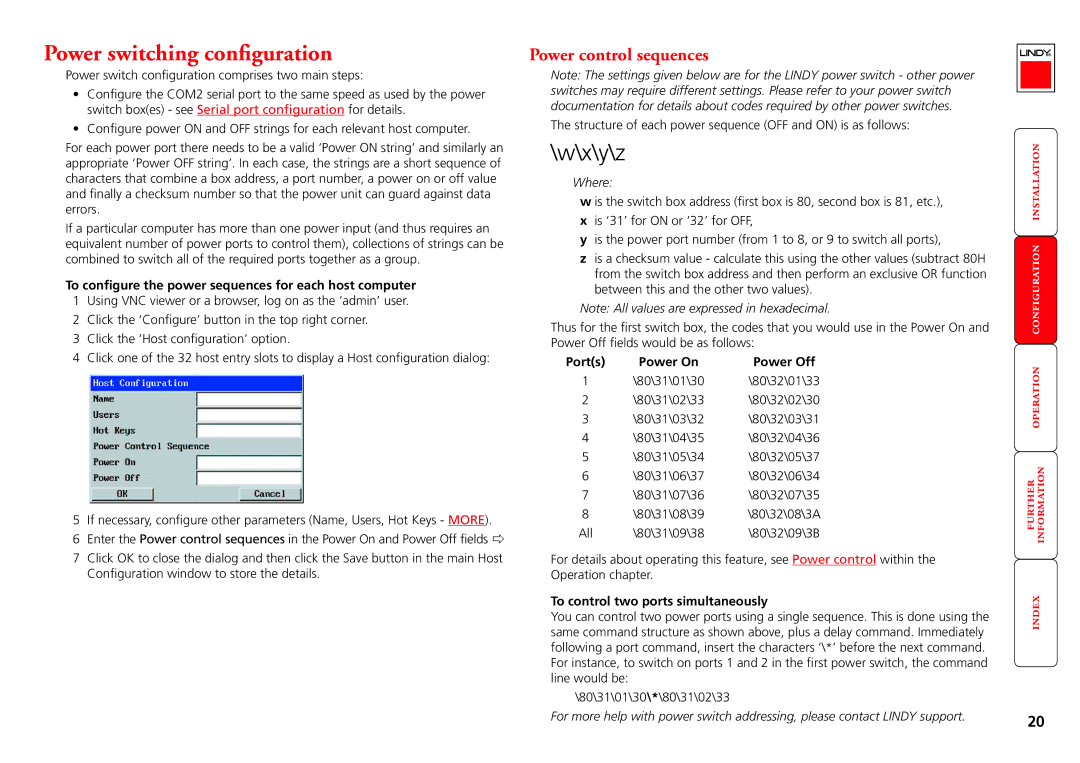
Power switching configuration
Power switch configuration comprises two main steps:
•Configure the COM2 serial port to the same speed as used by the power switch box(es) - see Serial port configuration for details.
•Configure power ON and OFF strings for each relevant host computer.
For each power port there needs to be a valid ‘Power ON string’ and similarly an appropriate ‘Power OFF string’. In each case, the strings are a short sequence of characters that combine a box address, a port number, a power on or off value and finally a checksum number so that the power unit can guard against data errors.
If a particular computer has more than one power input (and thus requires an equivalent number of power ports to control them), collections of strings can be combined to switch all of the required ports together as a group.
To configure the power sequences for each host computer
1Using VNC viewer or a browser, log on as the ‘admin’ user.
2 Click the ‘Configure’ button in the top right corner.
3 Click the ‘Host configuration’ option.
4 Click one of the 32 host entry slots to display a Host configuration dialog:
5If necessary, configure other parameters (Name, Users, Hot Keys - MORE).
6 Enter the Power control sequences in the Power On and Power Off fields ð
7Click OK to close the dialog and then click the Save button in the main Host Configuration window to store the details.
Power control sequences
Note: The settings given below are for the LINDY power switch - other power switches may require different settings. Please refer to your power switch documentation for details about codes required by other power switches.
The structure of each power sequence (OFF and ON) is as follows:
\w\x\y\z
Where:
w is the switch box address (first box is 80, second box is 81, etc.),
xis ‘31’ for ON or ‘32’ for OFF,
yis the power port number (from 1 to 8, or 9 to switch all ports),
zis a checksum value - calculate this using the other values (subtract 80H from the switch box address and then perform an exclusive OR function between this and the other two values).
Note: All values are expressed in hexadecimal.
Thus for the first switch box, the codes that you would use in the Power On and Power Off fields would be as follows:
Port(s) | Power On | Power Off |
1 | \80\31\01\30 | \80\32\01\33 |
2 | \80\31\02\33 | \80\32\02\30 |
3 | \80\31\03\32 | \80\32\03\31 |
4 | \80\31\04\35 | \80\32\04\36 |
5 | \80\31\05\34 | \80\32\05\37 |
6 | \80\31\06\37 | \80\32\06\34 |
7 | \80\31\07\36 | \80\32\07\35 |
8 | \80\31\08\39 | \80\32\08\3A |
All | \80\31\09\38 | \80\32\09\3B |
For details about operating this feature, see Power control within the Operation chapter.
To control two ports simultaneously
You can control two power ports using a single sequence. This is done using the same command structure as shown above, plus a delay command. Immediately following a port command, insert the characters ‘\*’ before the next command. For instance, to switch on ports 1 and 2 in the first power switch, the command line would be:
\80\31\01\30\*\80\31\02\33
For more help with power switch addressing, please contact LINDY support. | 20 |
|
